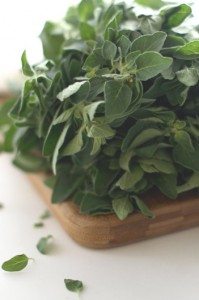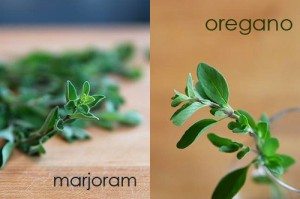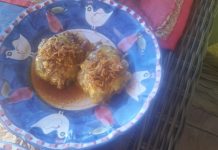Oregano: The Other Side of The Story
By: F.R.E.E. Will, editorial assistant and author of In the Spice Cabinet
In my last post for In the Spice Cabinet I was giving the rundown on marjoram and its many different names and manifestations and its relation to the spice oregano. So I figured it would be in the best interest of the readers out there if I cleared the picture up even further by discussing oregano and where it stands in the world of herbs compared to its more obscure cousin.
Oregano, like its cousin marjoram, is a member of the mint family and while a lot of the folklore history is shared between the two clearly there are distinctions between the two plants in regards to everything from taste to the color of the flowering tops. While conducting my research for the article I found out that there are a plethora of species (approx. 44), 6 subspecies, 3 varieties and even 18 hybrids that are found naturally in the wild. With all the different variants one would probably do well to think of oregano as more than a plant, but also a distinct taste on that can range from quite pungent to almost next to nothing depending on the variety cultivated (which, by the way, includes varieties of marjoram.)
Compared to marjoram, oregano has a much more pungent aroma and tends to be better known even by the most novice of culinary artists. The varieties most are probably familiar with is Origanum vulgare or O. vulgare hirtum, which has also been referred to as wild marjoram, both varieties being found and cultivated in parts of Italy and Greece. Both varieties are also the strongest in aroma and are the most commonly sold in marketplaces. Turkish/Cretan oregano (O. onites) is also heavily cultivated and is sometimes known as pot marjoram due to it being found in pots and home gardens and is said to be a suitable substitute in the kitchen to the Greek and Italian varieties. There are also two varieties of oregano native to the American continents, Lippia graveolens (Mexican oregano) and Plectranthus amboinicus (Cuban or Puerto Rican oregano), that while not part of the same genus or family as the Mediterranean variety (actually they are related to the verbena family of plants), share the same distinct taste and chemical content (just in different proportions) and are found in numerous Southwest and Latin-American cuisine.
Originating and cultivated throughout the Mediterranean (Northern Africa and Southern Europe) and Asia Minor, oregano has long been revered for its herbal properties even amidst the confusion between it and marjoram. Also because of its more pungent aroma and chemical composition, the oregano provides a potent effect when used. Some of the more notable uses for oregano outside of the kitchen include easing of cold and flu symptoms when taken as a tea, the stimulation of bile to aid the digestive process, and also relieves flatulence and the build-up of gas in the abdomen. Even the treatment of poisonous animal and insect bites has been known to be assuaged via the application of the herb topically. It was also known during the Middle Ages to ease sore throats and gums when gargled and alleviate toothaches through the application of the volatile oils. I also found during my research that the oil of oregano can also be used to treat head lice which can definitely come in handy when saving on treatments and doctor visits.
Present day research confirms most of what is already known of the benefits of oregano and has also shed light on its potent antioxidant quality making it the most powerful of all the herbs pound for pound. According to various studies including one from the Beltsville Agricultural Research Center, a teaspoon of the herb is said to contain the same antioxidant level as a medium sized apple. Studies have also shown that the anti-bacterial/anti-fungal/microbial/parasitic properties are second to none. Currently oregano is known to be effective against 25 different kinds of bacteria which include those known to cause food poisoning and is said to have an efficacy greater than that of some antibiotics.
Another study back in 2000 shows that 73% of participants suffering from intestinal parasites saw those same parasites (and related symptoms) reduced when using oil of oregano. The key compound behind these anti-(insert nasty pathogen here) qualities found in oregano is carvacrol. On top of being effective against harmful bacteria and parasites, the carvacrol in oregano is also known to be useful in inhibiting the growth of Candida albicans, naturally occurring yeast in our bodies that when left unchecked due to improper diet, and toxic elements (i.e. free radicals); can cause one of the most common yeast infections. It’s common ailments such as these that are subjected to a barrage of over-prescription of antibiotics (which by the way may clear what ails you but also depletes the body of other bacteria that helps to regulate pH levels and other useful functions) and later develop resistance leaving us with new and more dangerous “superbugs” and nothing strong enough to combat them. Yet a preventive step like a cup of tea with oregano and a few other choice herbs could’ve kept something like that in check eliminating the need for prescription after prescription; but I digress (or do I?).
Other compounds found in oregano include thymol and rosmarinic acid. Both of these compounds clear the body of free radicals that can over time cause cells to degenerate, mutate and in some cases become cancerous. Thymol specifically has anti-fungal properties that are no stranger to the dental industry; in fact it is a key ingredient in Listerine mouthwash. Rosmarinic acid on the other hand has been linked to alleviation of afflictions associated with the lungs including bronchitis and asthma. Because of such powerful antioxidant content, lately oregano has also been looked at as a means of lowering cholesterol, repairing damage caused by heart disease, and even slow the process of muscular degeneration.
To speak of oregano and not talk about its use in the kitchen would be downright blasphemous. For centuries people in Europe, particularly Greece and Italy, used oregano in a variety of dishes from roasted meats, pickled items, vegetables, and is also a key ingredient in the seasoning mixture bouquet garni. It is typically paired with basil and both tend to be synonymous with tomato sauce and collectively are known as “pizza herbs.” What’s funny is that oregano didn’t gain much popularity in the U.S. until the 1940s when soldiers brought it back along with the discovery of pizza. Ironically, what was once considered a poor man’s dish from the southern region of Italy and is now renowned throughout the world (and myself and the many pizza heads around the world thank them).
But of course pizza is not the only thing suitable to the flavor of oregano. Try adding fresh oregano to olive oil with basil, Dijon mustard and vinegar for an authentic Greek salad dressing. You can also add it to pesto to give it a different kick. Spicy dishes also tend to pair well with oregano and if you’re looking for something different to top off those bratwursts while you watch the boys of summer take to the diamond, try hot Italian giardiniera, a lovely marinated mixture of bell peppers, carrots, sliced jalapeños and herbs. And let us not forget tomato sauce which can lend itself to various pastas and of course pizza. Until next time, here’s to happy and healthy eating.















